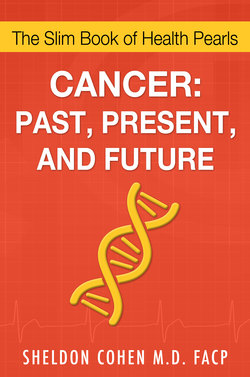Читать книгу Cancer: Past, Present, and Future - Sheldon Cohen M.D. FACP - Страница 3
На сайте Литреса книга снята с продажи.
CHAPTER 1 Definition
ОглавлениеI hate definitions.
Benjamin Disraeli
1804-1881
The definition of cancer evolves over time as knowledge increases. The 1963 World Book Encyclopedia defines cancer as “A very harmful growth in the body; malignant tumor. Certain types of cancer tend to spread to different parts of the body and destroy the healthy tissues and organs. Cancer is a change in the normal growth of cells, but the causes have not yet been fully determined.”
A more modern definition suggests that cancer is a group of over 100 different diseases characterized by uncontrolled cell growth with the possibility that the cancerous cells may migrate from the original site and spread to different distant body sites and cause death.
Since a cell is the basic underlying structure that “changes” from a normal functioning cell to a cancerous one, what is a cell?
All human beings—and for that matter all living things—have as a basic unit, a cell, microscopic in size, surrounded by a cell wall (membrane), and consisting internally of protoplasm, a substance made up of water in which is suspended proteins, fats, other molecules, and the nucleus. This nucleus, or cell brain, controls, through Deoxyribonucleic Acid (DNA), basic functions necessary for life itself: movement, thoughts, digestion, breathing etc. DNA works by utilizing a portion of itself (genes) that makes proteins that direct the body to carry on these basic functions.
That is a brief description of a single cell; there are 100 trillion cells in each human body (100,000,000,000,000). Is it any wonder that some of that myriad of cells could undergo changes evolving into malignant degeneration (cancer)?
Each cell of the human body does not live forever (the life of its host). Rather, the cell grows, divides and replaces itself. Each cell has genes that also produce the proteins that control cell growth and division. If the DNA molecule sustains damage to a gene segment responsible for this cell growth, faulty proteins are produced that perpetuate themselves with each now altered cell division. Hence restraints on cell growth vanish and an abnormal cell results, and this daughter cell can also perpetuate itself with each cell division eventually resulting in a large number of abnormal cells (new growth or cancer).
There are a number of possible reasons for developing abnormal cells:
•Genetics: the abnormal cell may be inherited from a parent or both parents
•Adverse lifestyle factor exposure impacting cell division
•Environmental exposures including tobacco smoke, alcohol, asbestos, ultraviolet radiation from the sun and others
•Viral infections including hepatitis (viral infection of the liver), HIV (Human immunodeficiency virus), HPV (Human Papilloma Virus)
In general then, it is this repetitive irritation to body organs or parts that directly affects the DNA of cells causing the permanent changes that pass to future generations in the form of an abnormal growth (malignant tumors—cancer).
Three quick examples:
1.Cigarettes chronically irritate the trachea, bronchial tubes, lungs, kidneys, urinary bladder, and pancreas.
2.Barbequing meat at high temperature causes the formation of heterocyclic amines considered carcinogenic (cancer promoting).
3.Alcohol excess incriminated in cancer of the digestive tract, breast, liver.
It has been estimated that if people did not put those three things in their mouths, 75 percent of all cancers would never start. Think what that would do to mitigate our healthcare crisis.
Ordinarily, amongst other functions, our immune system is geared to prevent the formation of cancer. The immune system consists of a collaborative mechanism that protects us from disease by utilizing a sophisticated team of specialized organs, and cells circulating throughout the body that differentiate self from non-self. This ability is due to the fact that all body cells carry distinctive molecules (epitopes) on their surfaces that identify it as self. Immune cells, recognizing this self-marker, coexist peacefully in a state known as self-tolerance. On the other hand, altered or foreign cells or organisms that do not carry this self-marker, such as cancer cells, will find themselves subjected to an all-out vigorous assault by the immune system, the principle actors of which are white blood cells known as lymphocytes that recognize these damaged cells as foreign and destroys them before the cells can divide and perpetuate themselves. However, some cells may escape this surveillance system resulting in a cancer that could eventually kill its host.
Interestingly, this basic structural etiology of cancer has been known only for the last sixty years when Watson of the United States and Crick of England worked out the helical structure of the DNA molecule and won the Nobel Prize in Medicine. Progress slowly evolved in understanding cancer from this point on.
Cancer then, basic to our very being, involves life at its origin; cell growth gone awry. And as it takes this turn, mankind struggles to understand a disease involving the very basic physiological underpinning of life itself; God’s secret. Is it any wonder why the task has been so difficult? Cancer remains the number two cause of death, second only to heart disease. Our task, in the future, remains to tame these twin killers; a daunting task as cancer kills 1,500 people per day, or about one-half million per year.
Although cancer can occur at any age from infancy on, it is basically a disease of the elderly; over 77 percent of cancers occurring from age 55 on. One out of every four deaths in the United States occurs from cancer. In a lifetime, 50 percent of men and 33 percent of women will develop cancer. In men, the three leading causes of cancer are prostate, lung and colorectal cancer; in Caucasian women, the leading causes of cancer are breast, lung and colorectal cancer. The most common cancer in children ages 14 and younger are the leukemias, and only five percent of cancers are hereditary.
Statistics for cancer survival have improved over the years and the five-year survival rate for all cancers is 86 percent.
